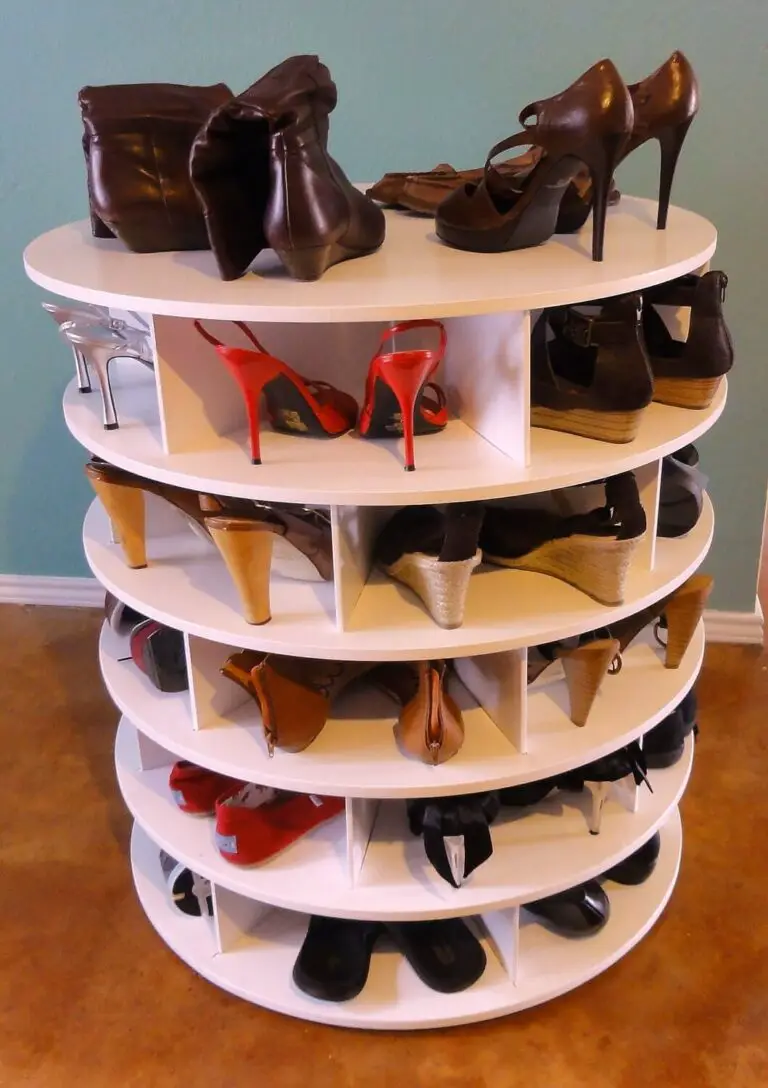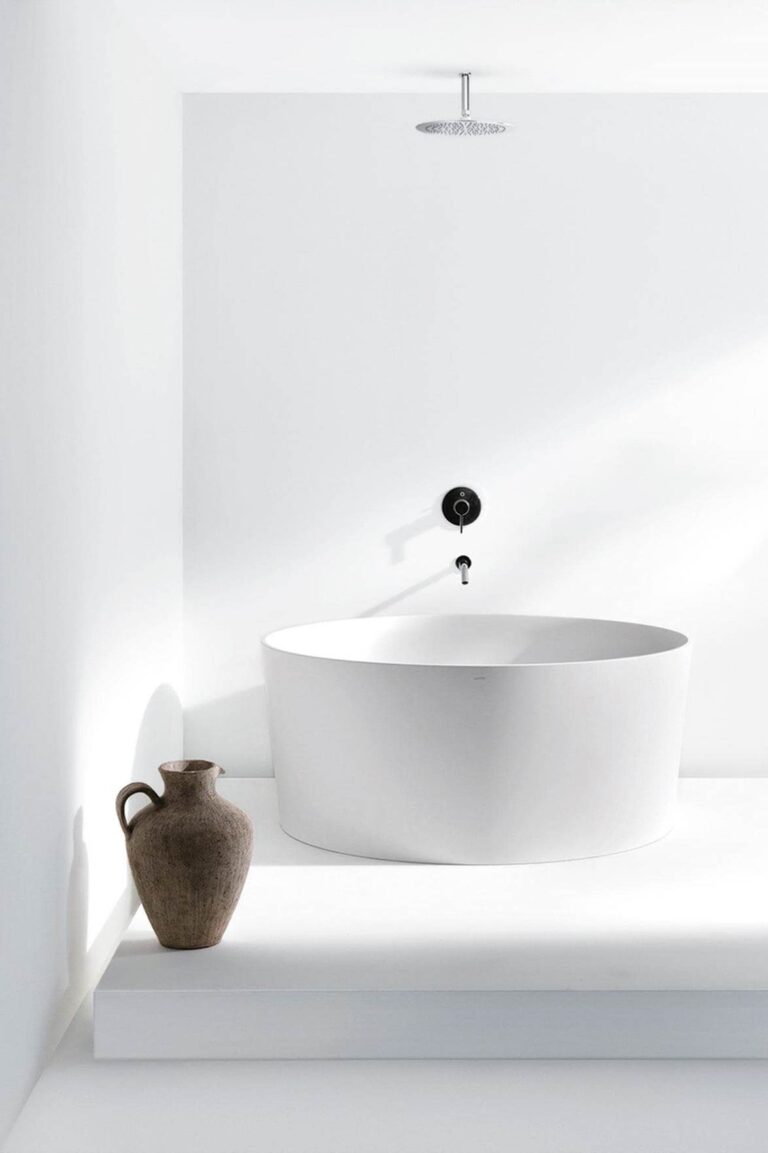38+ Best Coffered Ceiling Ideas And Designs
When it comes to upscaling a room, installing a coffered ceiling can be an effective and stylish way to do so. Often mistaken for tray ceilings, coffered ceilings offer a unique aesthetic with sunken panels that add depth and visual interest. If you’re looking for ways to give your ceiling a vintage or retro look, a coffered ceiling is definitely worth considering.
In this post, we’ll explore some of the most notable and themed coffered ceiling designs out there, from traditional to modern and everything in between. Whether you’re looking to add some rustic charm, geometric flair, or contemporary sleekness, there’s a coffered ceiling style that’s sure to fit your taste. So, without further ado, let’s dive in.
What is a coffered ceiling?
The origins of coffered ceilings can be traced back to the baroque style and early Renaissance era, where indentations in the ceiling were considered a monumental feat, particularly when made from stone. This architectural feature has always been associated with nobility and the elite due to the expense of materials and intricate craftsmanship required.
The primary purpose of coffered ceilings remains unchanged – to create visually appealing indentations using various grid shapes.
These grid shapes come in a range of polygonal forms, including squares, rectangles, circles, and ovals.
Some key advantages of coffered ceilings include their design flexibility, durability, and resistance to sagging and mold growth.
What is the purpose of a coffered ceiling?
A coffered ceiling’s primary function may be to add a touch of vintage flair to your home, but its benefits extend far beyond aesthetic appeal. In addition to creating the illusion of depth through its sunken panels, this design element also enhances the sense of space within a room, making it feel more expansive and airy. Furthermore, coffered ceilings can serve as a sound insulator, reducing excess noise and increasing overall soundproofing.
This feature is particularly valuable in homes with high or mid-height ceilings, where echoes can be especially pronounced. The design also has the added benefit of concealing structural flaws, providing a sense of cohesion to the room’s overall aesthetic.
Types of coffered ceilings
Cofferred ceilings, having been previously highlighted for their adaptability and diversity, can be tailored to suit a wide range of design preferences. Among the numerous design styles available, four distinct categories stand out:
Traditional coffer
The Waffle style boasts a unique characteristic – small, evenly spaced squares or rectangles that form a grid pattern within a beam box. While you can certainly incorporate ceiling styles to enhance its appearance, the most common approach is to install crown molding inside this design, which adds an extra layer of sophistication.
Rustic coffer
While traditional coffers often feature ornate moldings and finishes, rustic coffer designs take a more straightforward approach. Instead of relying on added embellishments, they showcase raw, distressed wood beams in their natural state. This unadulterated aesthetic makes them an ideal choice for those aiming to achieve a country-inspired or farmhouse-style look, where the emphasis is on simplicity and a connection to nature.
Geometric coffer
To add an extra touch of elegance, consider adorning your coffered ceiling with intricate geometric patterns like triangular grids, octagonal arrays, or hexagonal formations. This can be achieved by boxing in beams and installing additional molding details to create a dramatic and sophisticated visual effect.
Contemporary coffer
For those who appreciate simplicity, this design embodies the essence of minimalism. Its symmetrical and neatly arranged grid patterns, coupled with exposed beams, create a visually appealing combination that’s often framed using natural wood and finished with drywall. This aesthetic is affectionately known as the coastal style, evoking the clean lines and effortless charm of seaside architecture.
38+ Best Coffered ceiling ideas
As we’ve established the groundwork, it’s time to explore a treasure trove of coffered ceiling concepts that can elevate your home. To provide you with a diverse range of possibilities, I’ll be categorizing these ideas to help you find the perfect fit for your unique space.
Living room coffered ceiling

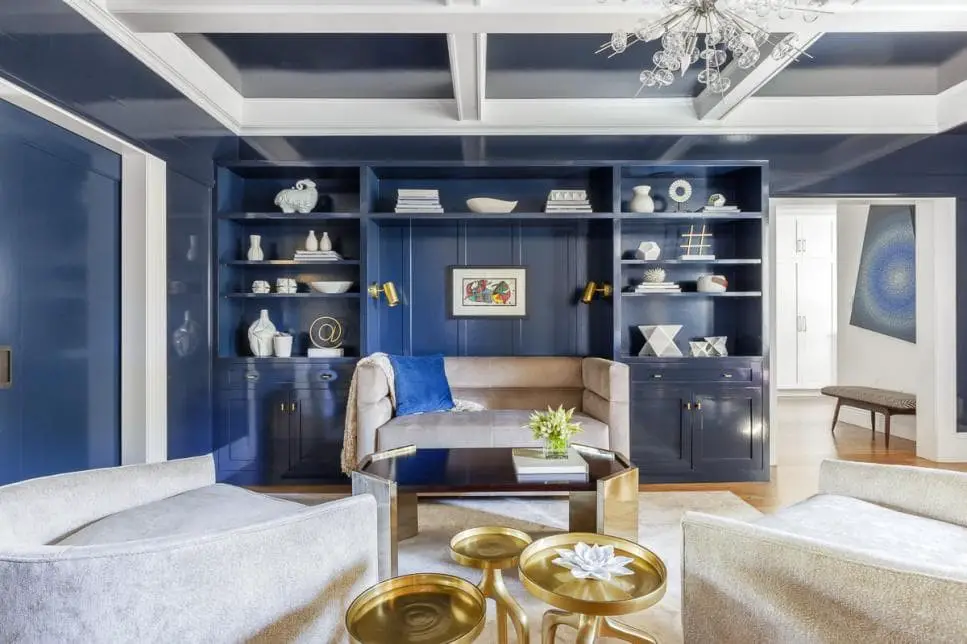
For those seeking a harmonious blend of styles, consider investing in a statement piece that effortlessly combines contemporary, chic, rustic, and traditional elements. The thick, finished beams evoke the grandeur of Roman architecture, while the accompanying furniture and accent pieces infuse the space with a touch of modern lightness and airiness.
This design inspiration can also be applied to creating a coastal-inspired living room with a two-toned aesthetic.
The box-style coffered ceiling serves as a stunning focal point, reminiscent of Victorian drawing rooms in its elegance and sophistication.
Modern coffered ceiling
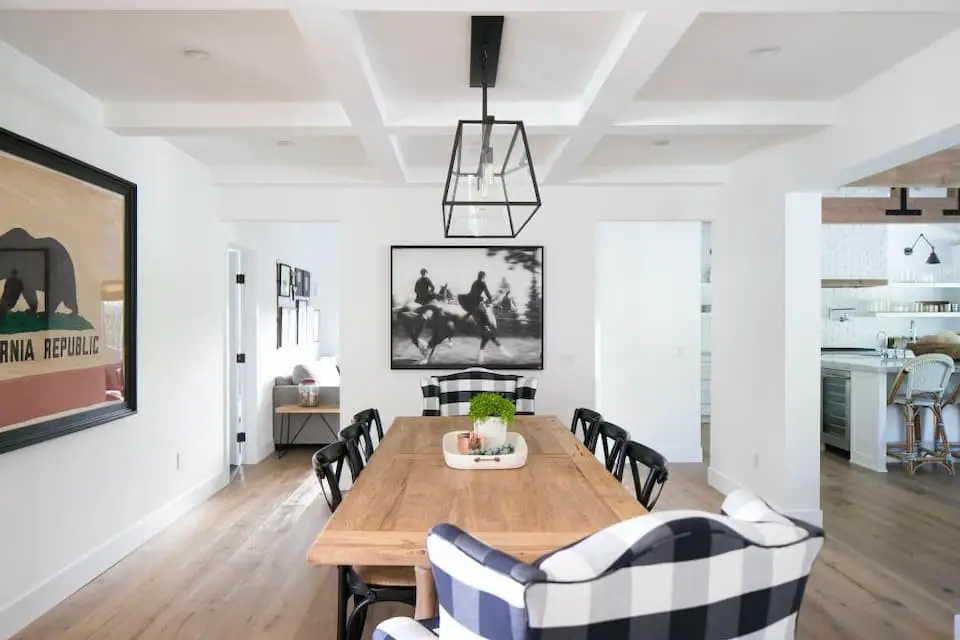
In modern constructions of coffered ceilings, the structural aspect often takes a backseat as attention is shifted towards acoustics. This shift in focus aims to minimize echoes and create a more harmonious sound environment within rooms. However, this doesn’t mean that decorative value has been compromised entirely. Minimalist designs paired with traditional boxed coffered ceilings can still provide a sense of neatness while making a significant visual impact.
The clean lines and subtle nuances of modern designs allow for a perfect balance between functionality and aesthetics.
Wood coffered ceiling
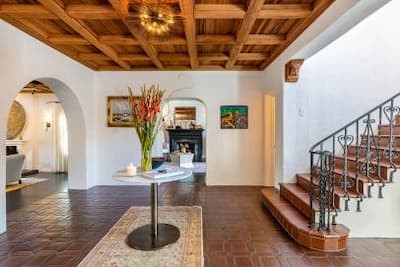
In this Mediterranean-inspired foyer, a beautifully crafted coffered ceiling takes center stage. The design’s understated elegance stems from its simplicity, featuring warm and rich hardwood tones that evoke a traditional waffle pattern. The pièce de résistance is the stunning Sputnik chandelier, which adds a touch of modern sophistication to the space.
As a nod to the home’s Spanish style roots, the coffered ceiling cleverly incorporates elements reminiscent of the 1930s era, further enriching the overall aesthetic.
Kitchen coffered ceiling

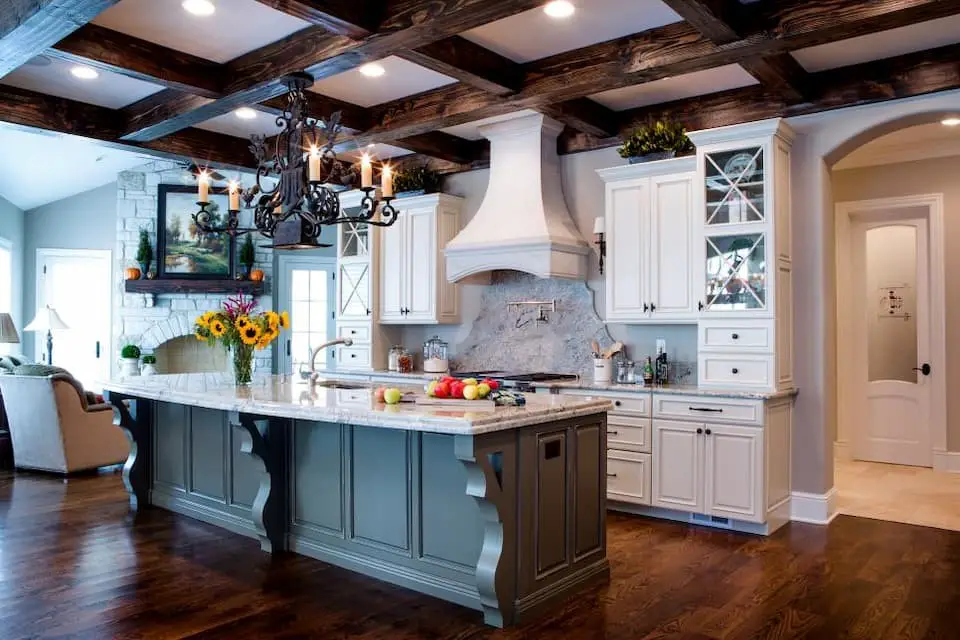
For those who appreciate grandeur and drama in their kitchens, an elegant space with coffered ceilings is sure to impress. The whimsical geometric indentation at the center of the ceiling’s traditional box beam design adds visual interest, while the pendant light’s placement creates a striking focal point. The asymmetrical shape of the ceiling contributes to its dramatic flair, which is further enhanced by the crown molding and intricate cabinetry.
If you have lower ceilings but still want to incorporate coffered ceilings into your rustic or farmhouse kitchen, consider using exposed wood beams with a uniform finish that matches your flooring. This design element adds warmth and coziness to the space. To complete the look, hang a wrought iron chandelier from the beams for a cohesive, contemporary-rustic aesthetic.
Bedroom coffered ceiling


In this coastal-inspired bedroom, a coffered ceiling with varying textures creates visual interest. The combination of wood plank inlays and exposed beams produces a striking contrast that adds depth to the space. Meanwhile, the uniform wood flooring and cohesive design maintain a sense of harmony.
Master bedroom coffered ceiling
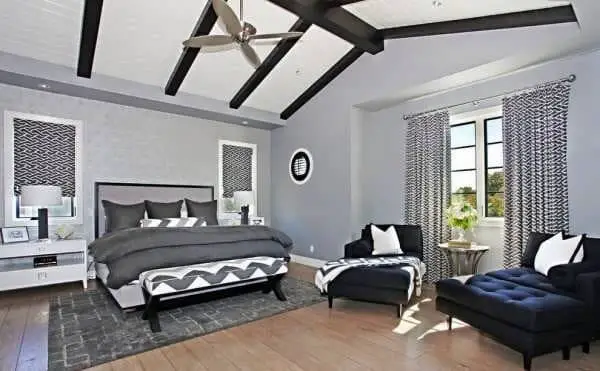
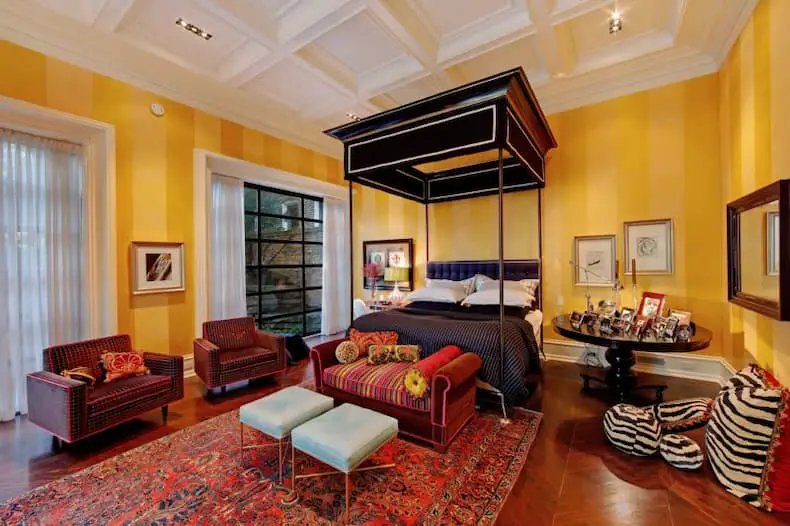
For a truly unique and visually striking approach, consider incorporating vaulted coffered ceilings into your design. The hallmark of this style is the creative use of ceiling indentations, which can add depth and visual interest to any space. In this modern bedroom, polished exposed beams in a Craftsman style create a stunning focal point that draws the eye upwards.
The neutral color palette also contributes to a sense of calm and serenity, allowing the bold tones and patterns from the rug and seating to take center stage. When paired with an all-white coffered ceiling, this look becomes even more cohesive and polished, effectively anchoring the room’s many design elements and creating a sense of luxury and sophistication.
Dining room coffered ceiling


A cohesive kitchen-dining space can be achieved by installing a coffered ceiling, which creates a sense of luxury and grandeur. This design approach effectively frames the entire area, drawing attention to the dining space. The traditional box beam is an excellent choice for creating a warm, intimate atmosphere, particularly in a dining room. The deep indentations add depth and texture, while wood and glass details evoke a vintage feel.
In low-ceilinged dining rooms, consider amplifying the indentations to create a sense of visual interest and depth. This approach can transform even the most modest spaces into inviting areas. For instance, the featured suburban dining room boasts a harmonious color scheme that extends from the walls to the ceiling, complemented by warm wood flooring and subtle dining room details. The overall effect is a cozy, inviting space perfect for enjoying meals with family and friends.
Coffered ceiling in bathroom
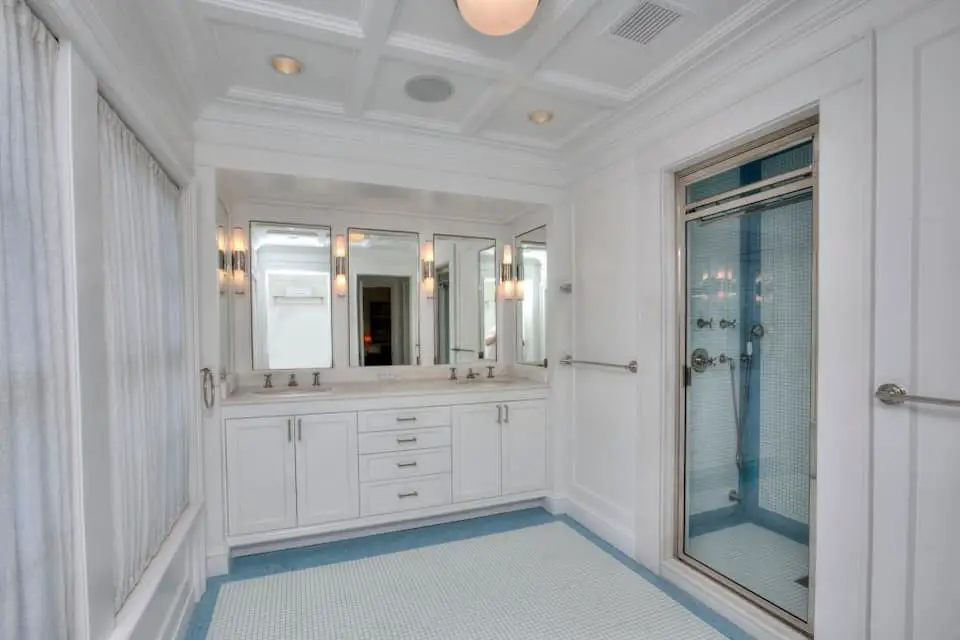
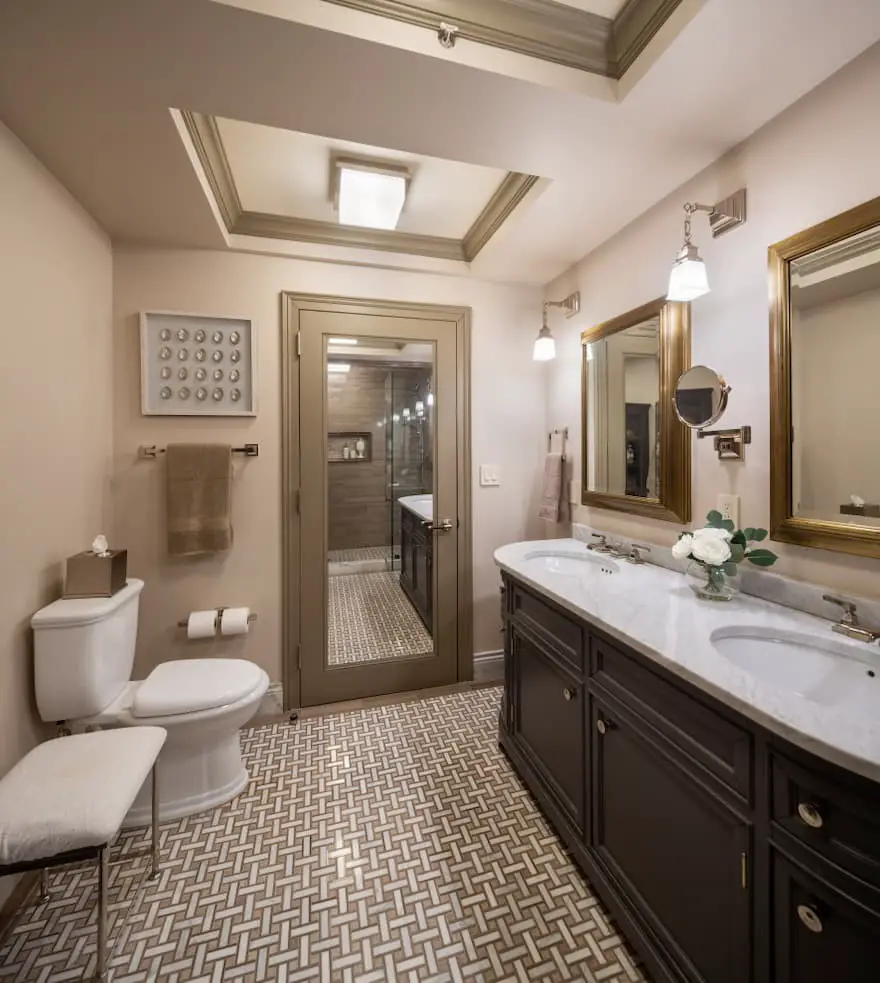
Imagine stepping into an ancient Roman bath, where shallow coffered ceilings meet stacked stone walls and flagstone flooring. That’s the level of drama this bathroom style can bring. In this luxurious compact space, shallow coffered ceilings appear to float effortlessly above warm-toned surfaces, illuminated by sconce lights and canned lighting that creates a sense of minimal depth yet abundant airiness. When it comes to deeper coffered ceilings, we find ourselves drawn to the warmth they bring.
The wood, glass, and mosaic accents in this bathroom create a visually appealing harmony, while thick doors and mirrors subtly emphasize the ceiling’s dramatic indentations. This cohesive design is reminiscent of a luxurious retreat.
Coffered ceiling lighting
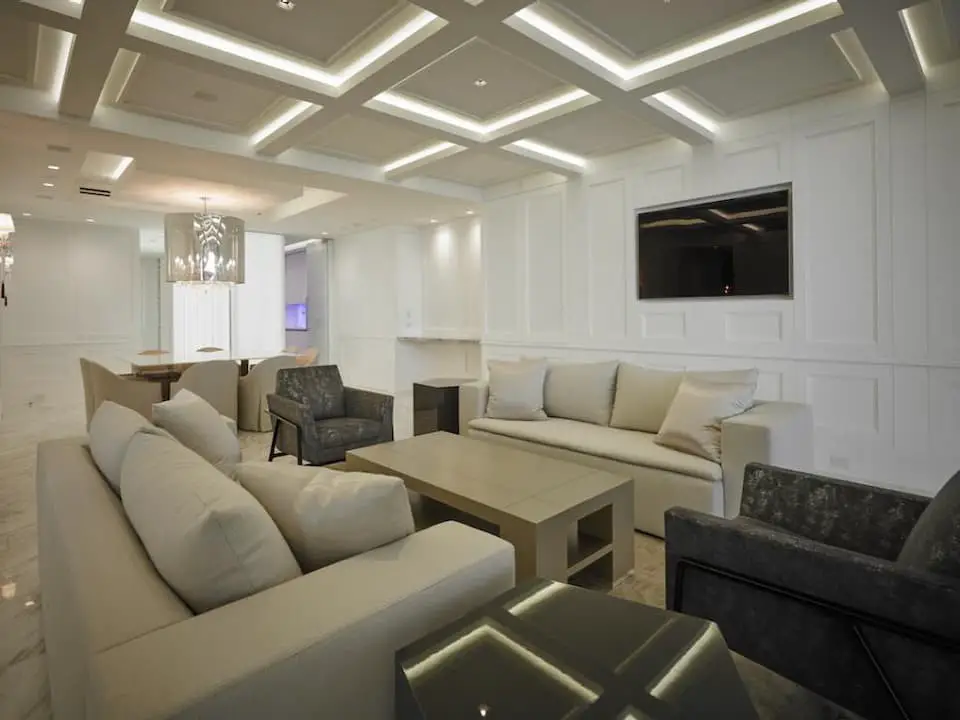
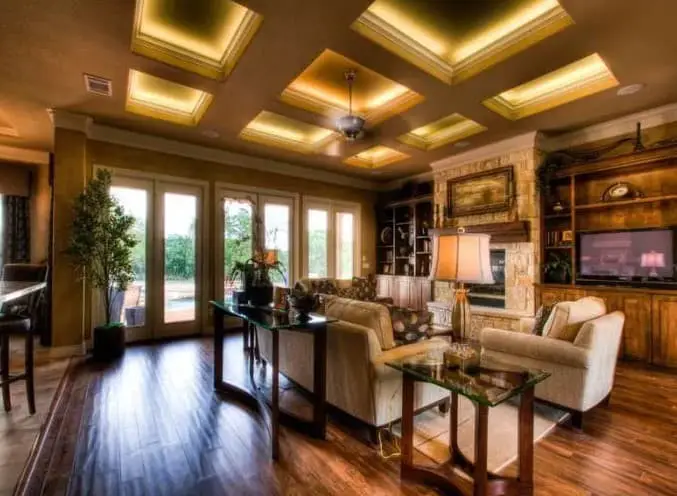
The ceiling lighting options for coffered ceilings are remarkably diverse. While canned lights are a popular choice, they can be effortlessly combined with other types to create a unique ambiance. To preserve the opulence of a modern living room featuring black and white tones and coffered ceilings, consider using hidden bright lighting between trims in conjunction with canned lights at the center. This clever approach maintains the sense of luxury while adding depth and visual interest.
For a rustic or farmhouse-inspired space, warm lighting can be used to create a cozy atmosphere. Here, a central pendant light instead of traditional canned lighting creates an intimate ambiance that’s perfect for relaxing.
Faux coffered ceiling
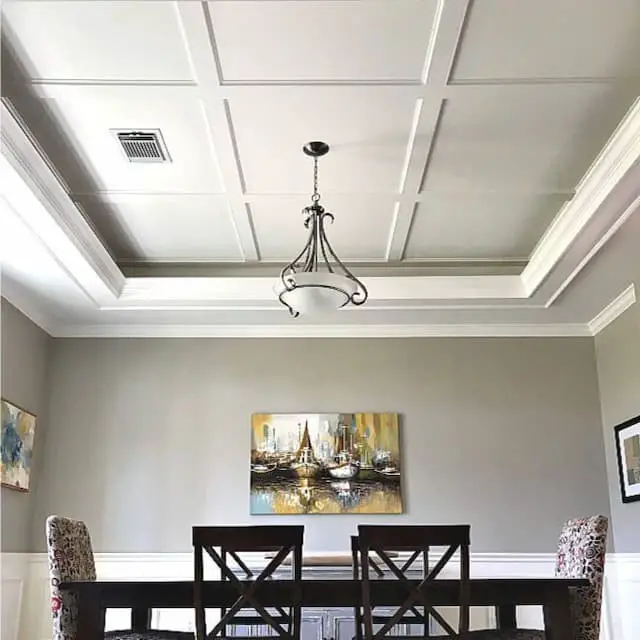
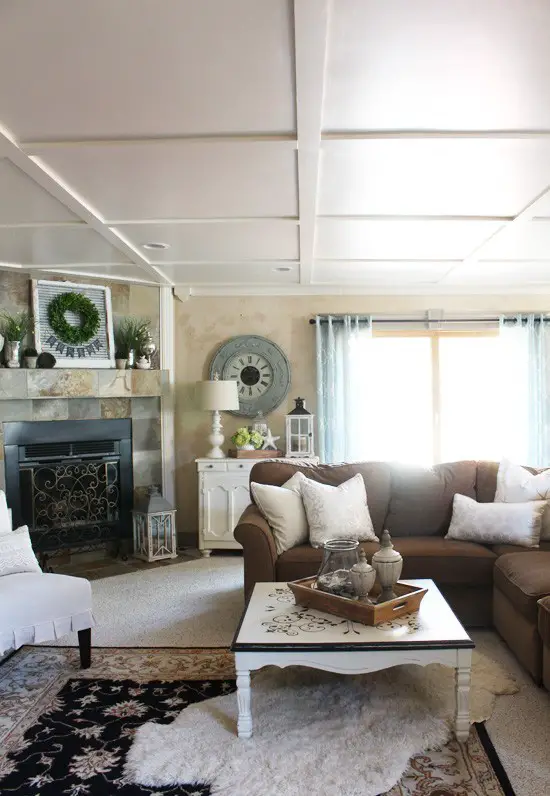
For those with lower ceilings, mimicking the look of coffered ceilings can be achieved through faux coffered designs. By installing beam panels along the perimeter and crossing them over in a grid pattern, you can create the illusion of decorative indentations without the need for an actual tray ceiling. This approach offers a minimalist aesthetic that can still make a significant impact on the overall look of your space.
Coffered ceiling paint ideas
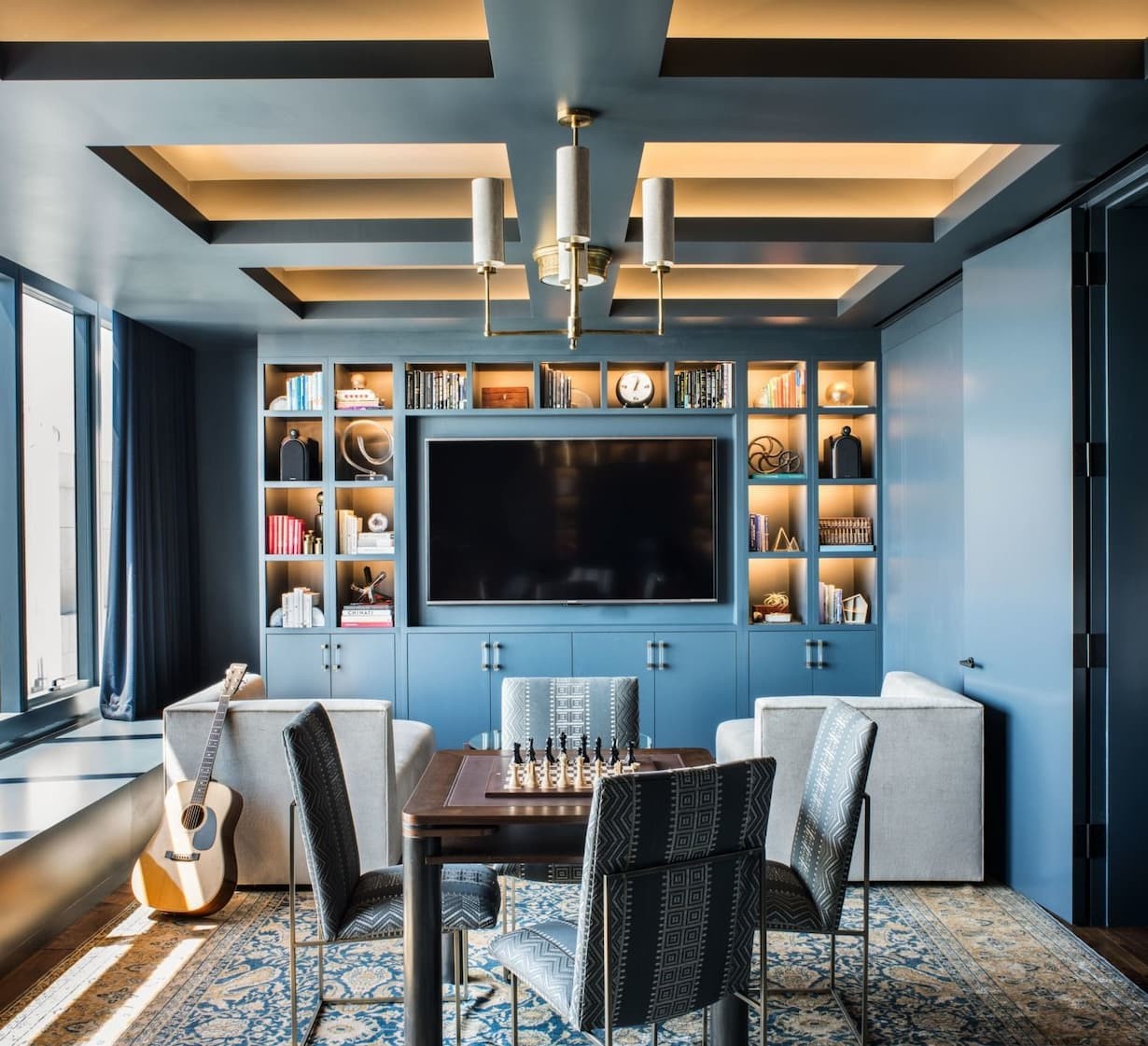

Elegance knows no bounds when it comes to neutral tones, and their versatility is simply unmatched. The coffered ceiling with its warm, glowing hidden lights across geometrical beams is a masterclass in style. However, if you want to take things to the next level, combining neutrals with pastel hues can create a truly show-stopping effect.
In this instance, the traditional coffered ceiling boasts impressive depth, thanks to its waffle-style design, which effectively covers the room and creates a cozy atmosphere. The canned and pendant lights overhead complement the bright white walls perfectly, resulting in a harmonious and inviting space.
Coffered vaulted ceiling
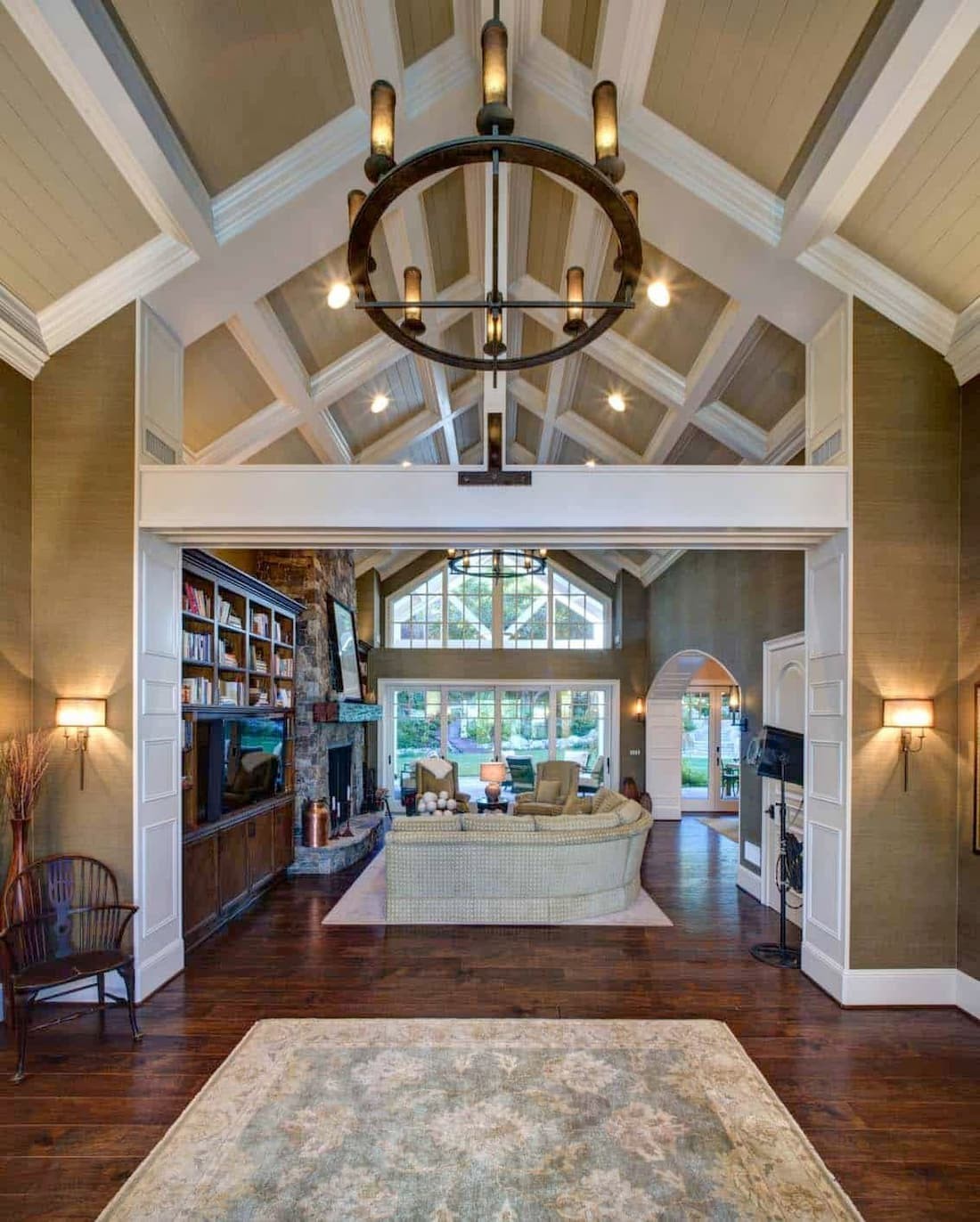
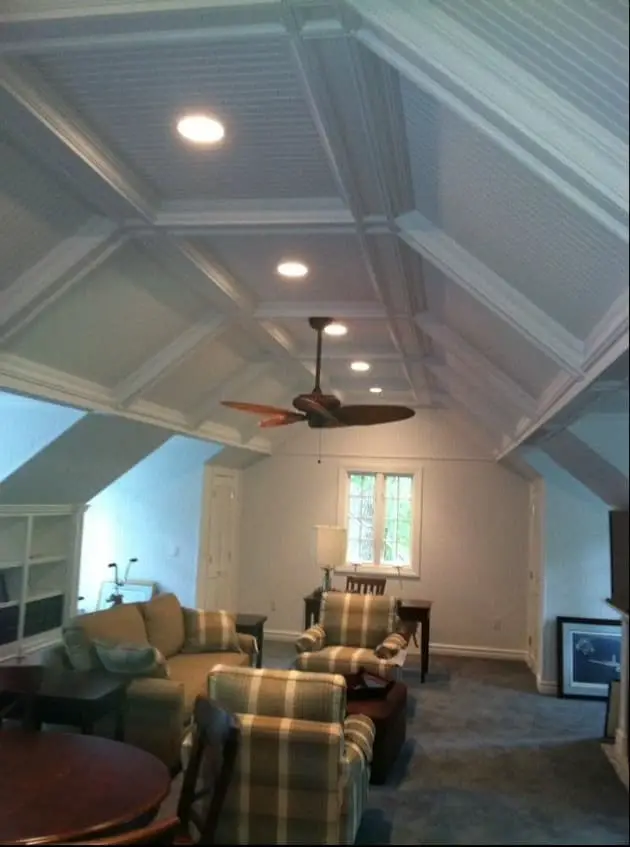
Transform your living space with the drama and texture of a coffered vaulted ceiling. This design element can add angled dynamics to a room, offering a range of styles from dome-inspired to Cathedral-esque. In this Craftsman bungalow, the entire stretch of the ceiling is styled with a coffered vaulted design, perfectly complemented by the geometric lines of the Cathedral beam between the foyer and living room.
The subtle contrast between the modern candelabra chandelier and the beige wood planks adds visual interest to the space. For an even more dramatic look, consider incorporating traditional barn-style angles into your design. This stunning attic room is elevated by its vaulted coffered ceiling, which creates a sense of depth and dimensionality that speaks for itself.
Coffered ceiling beams
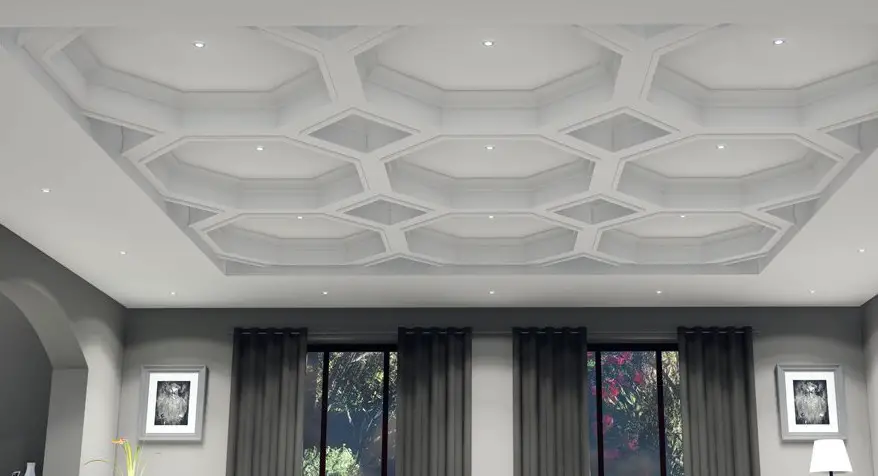
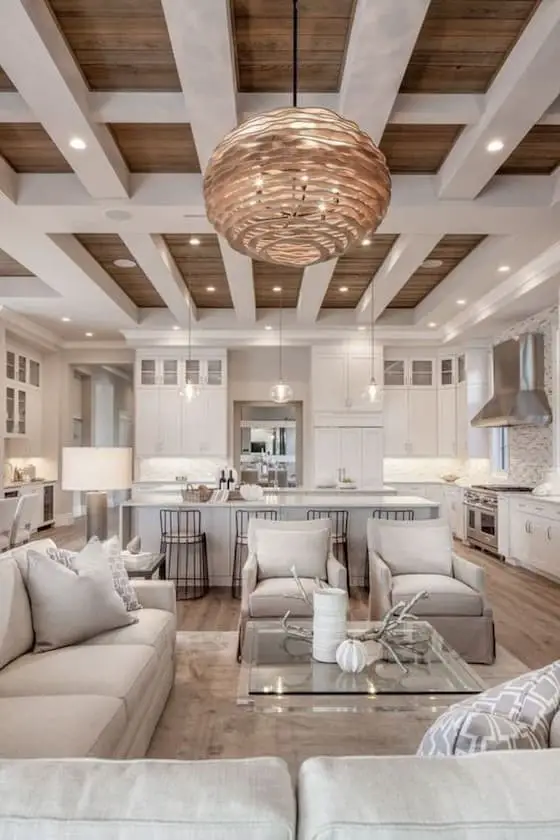
Coffered ceiling beams bring a unique dimensionality to traditional coffered ceilings, boasting a thicker, more three-dimensional appearance that instantly adds character to any space. This waffle coffered ceiling, already a geometric masterpiece, is elevated to new heights with the exposed beams, which introduce a sense of defined edges and visual interest.
Source: Mouldex Mouldings
For a sophisticated take on sunken ceilings, these concrete coffered beams in rectangular patterns deliver a plush, high-end aesthetic that’s impossible to overlook. The harmonious union of warm wood planks and the industrial edge of concrete creates a modern, transitional space that’s both refined and statement-making.
Coffered ceiling with crown molding

To achieve a cohesive appearance in the room, installing crown moldings is an effective way to create a sense of continuity. By incorporating these moldings into the design, you can instantly create a symmetrical look that ties together disparate elements in the space. In the example provided, the installation of a faux coffered ceiling effectively defines the area between the kitchen and island, creating a clear separation between the two zones.
This subtle yet impactful addition enhances the overall aesthetic of the room without overpowering its other design features.
Basement coffered ceiling

To transform your damp basement into a cozy family haven, bar, or entertainment space, consider incorporating a coffered style ceiling that exudes high aesthetics. A shallow coffered design with hidden, bright lighting can be particularly effective in creating a warm ambiance. This look is equally well-suited for dens and small dining areas, as well as basement doors featuring matching box-type accents.
With its versatility and visual appeal, the coffered style ceiling is an excellent choice for anyone looking to elevate their basement space.
Beadboard coffered ceiling
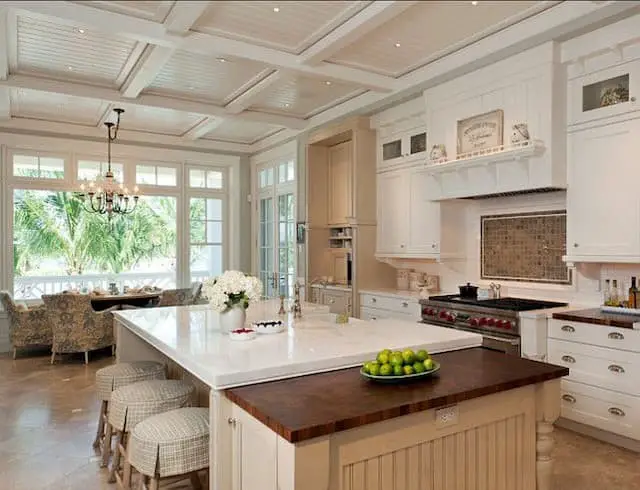
Beadboard coffered ceilings are a popular choice when it comes to shallow designs that incorporate shiplap or wood planks. The lightweight nature of this material makes it an ideal option for faux coffered ceilings and subtle indentations, where the goal is to add visual interest without overwhelming the space. For those seeking inspiration, consider the simplicity of a well-executed beadboard coffered ceiling, which can be a great starting point for any interior design project.
Contemporary coffered ceiling
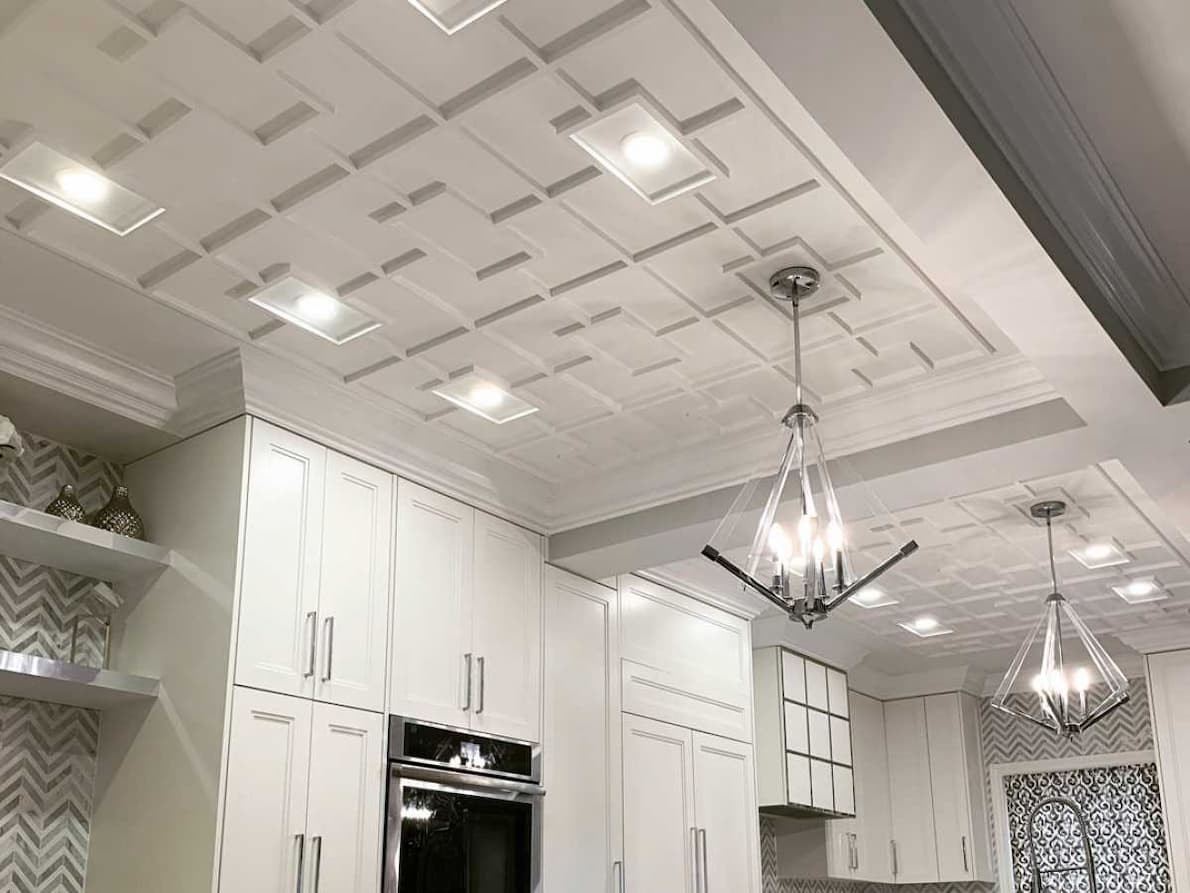
To achieve an eclectic, contemporary ambiance in your space, consider incorporating a geometric pattern into your coffered ceiling design. This clever approach can instantly revitalize the look of your room. For instance, take this all-white kitchen where industrial lighting fixtures, steel trims, and herringbone accent walls harmonize beautifully with multi-paneled contemporary coffered ceilings.
Craftsman style coffered ceiling

A Craftsman-inspired design often features wood accents, angled ceilings, and exposed beams. To elevate this classic aesthetic, consider incorporating mosaic-style coffered ceilings that seamlessly blend vintage charm with modern flair. This opulent look is the perfect fusion of nostalgia and contemporary sophistication.
Black coffered ceiling
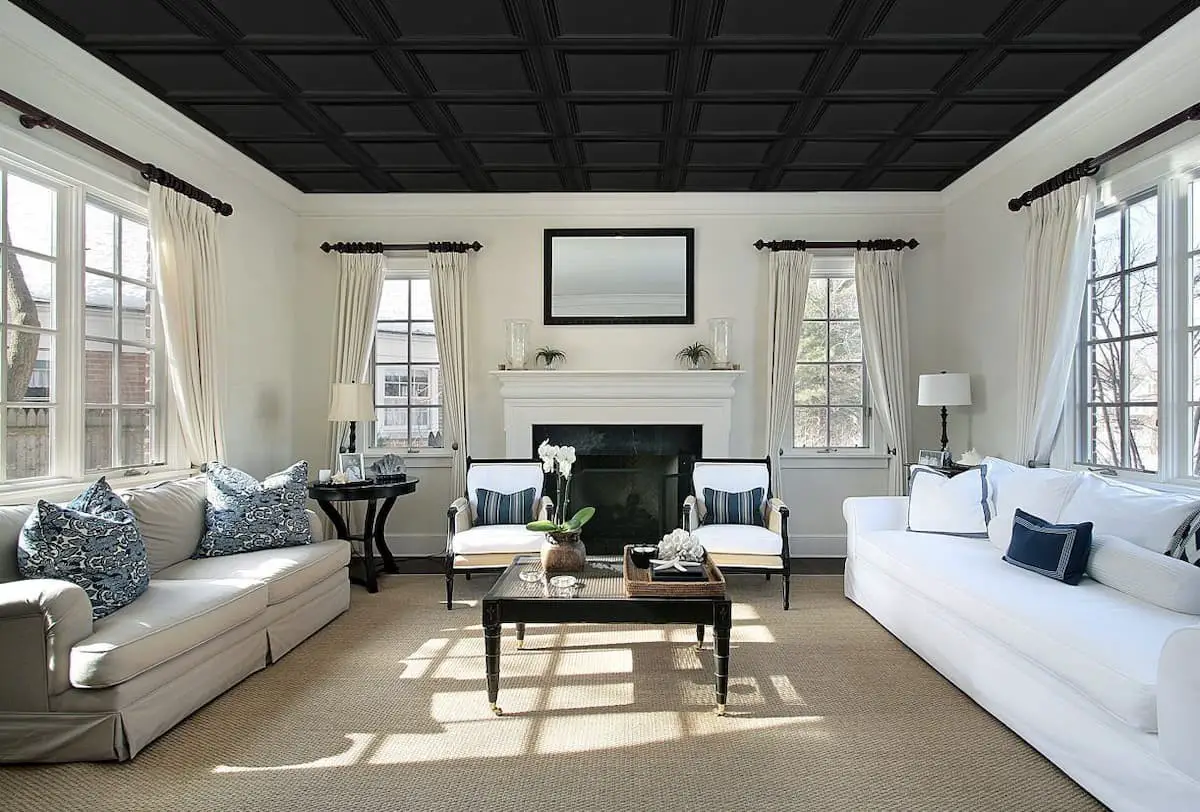
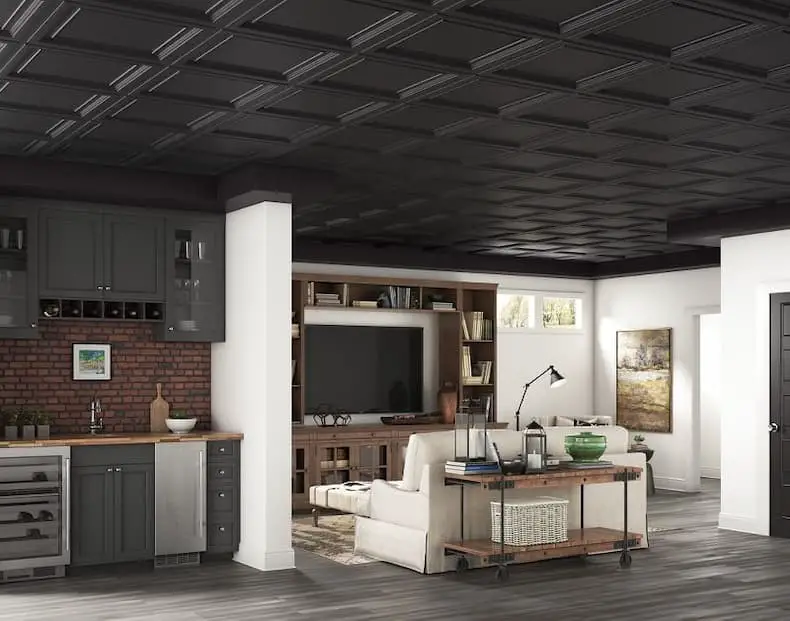
A dramatic visual balance is struck by the juxtaposition of the all-black waffle coffered ceiling with the crisp white walls, imbuing the space with an air of vintage charm and mystery. The clean lines of the minimal black accents on window trims, mirror frames, and furniture subtly introduce a modern aesthetic, harmoniously blending contrasting styles. In this industrial-inspired setting, the box beam coffered ceiling takes center stage, casting a brooding yet captivating atmosphere.
As a striking focal point, it perfectly complements the significant splash of white walls in one corner, effectively transitioning the space into an industrial studio-like haven.
Grey coffered ceiling
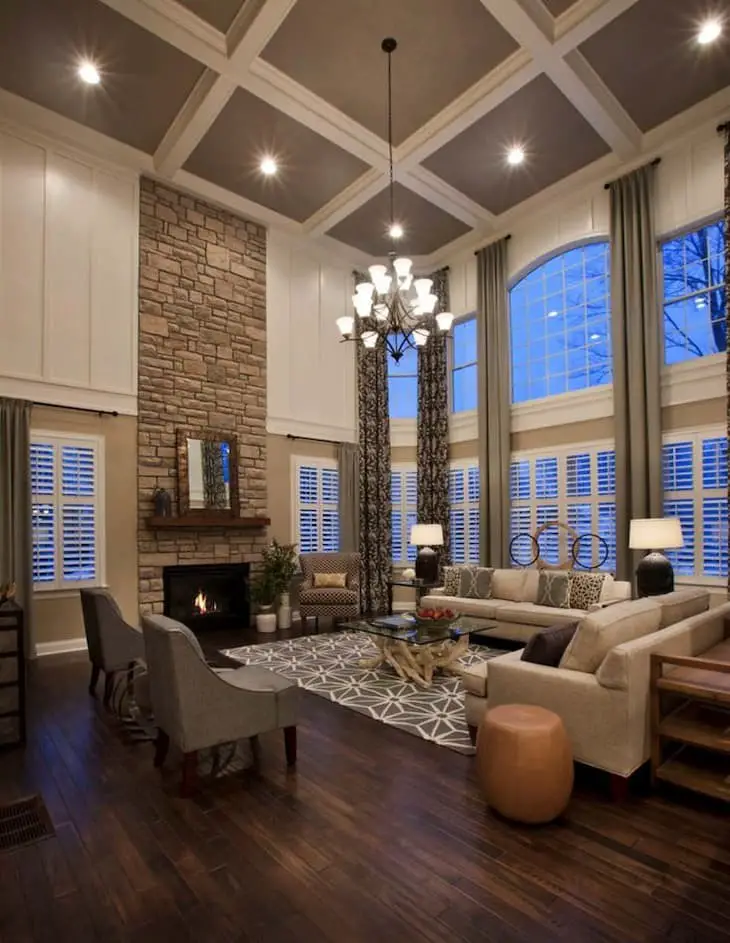
For those seeking a subtle yet striking coffered ceiling design, grey is an excellent choice for high-ceiling living rooms. When paired with bright, canned lights and an ornate chandelier suspended from the center, the neutral palette can be transformed into a lavish and opulent atmosphere, adding depth and visual interest to the space.
Single coffered ceiling
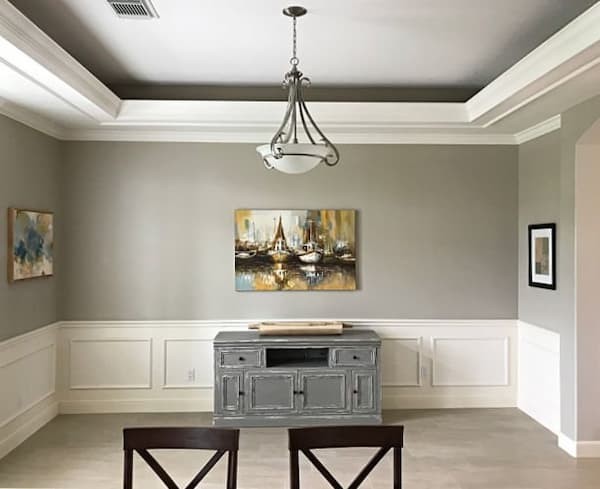
While coffered ceilings share some similarities with tray ceilings, the defining characteristic of this style lies in its deeper indentation. The upward curvature along the beam’s perimeter provides an ideal opportunity for concealing lighting and adding decorative accents to the ceiling. This design element offers a simple yet effective way to enhance the overall aesthetic.
Drywall coffered ceiling
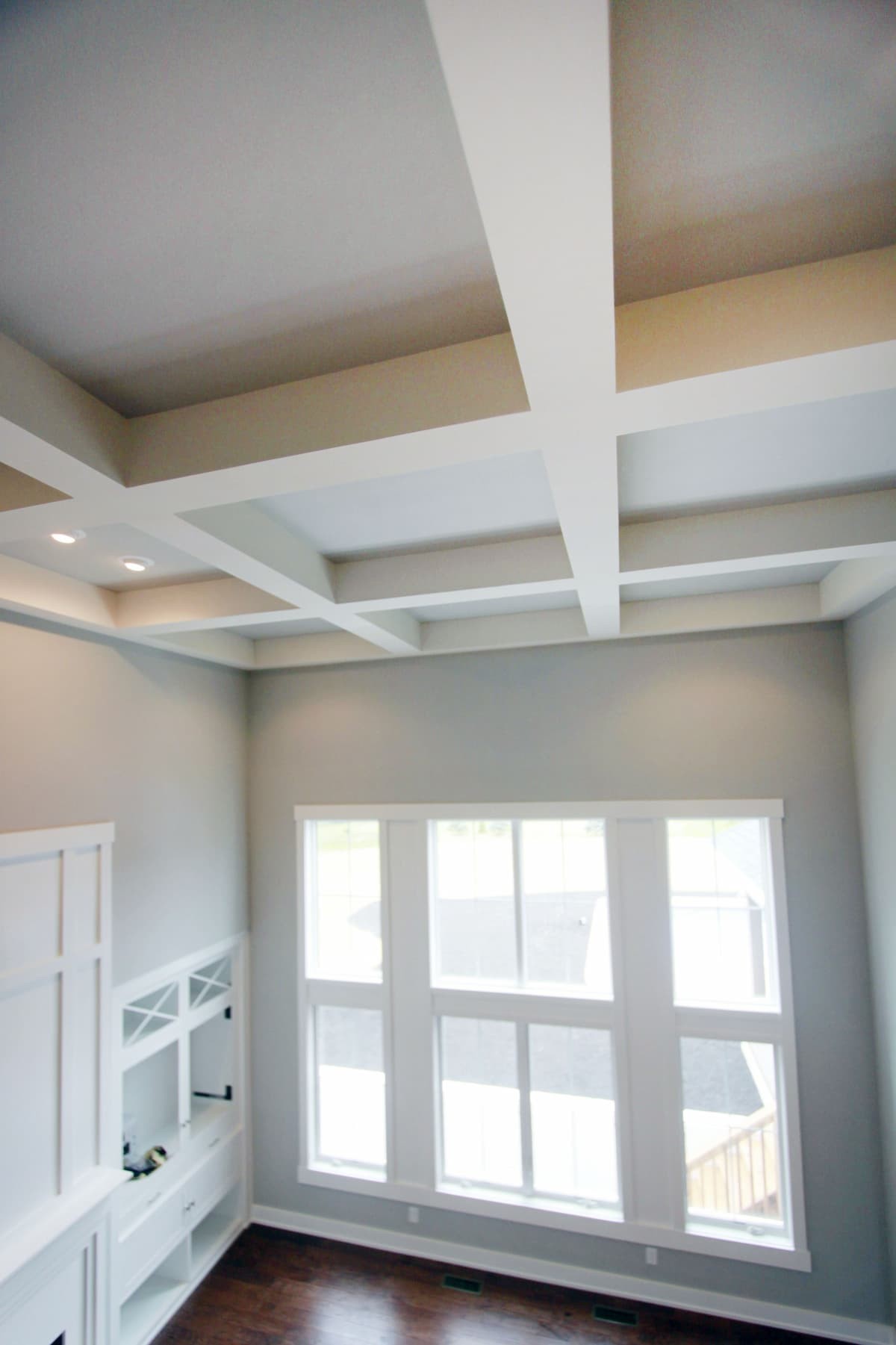
Drywall coffered ceilings offer a budget-friendly solution for creating shallow or faux architectural details in the ceiling. Unlike beadboard, which can be more labor-intensive to install, drywall is lightweight, durable, and easy to work with. When installed as flat beams, it creates a seamless look that’s perfect for achieving a coffered effect without breaking the bank. The resulting kit resembles a series of shallow recesses or panels, adding depth and visual interest to any room.
Reclaimed wood coffered ceiling
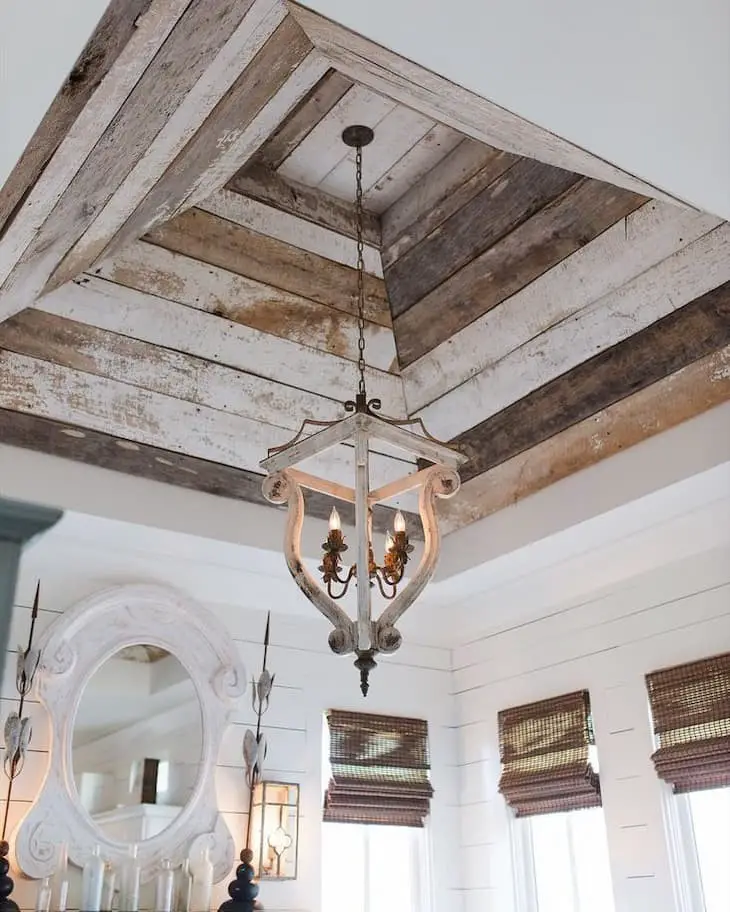

Reclaimed wood’s versatility knows no bounds, allowing it to be stained, distressed for a rustic coastal vibe or painted with richer brown tones for added warmth. This ceiling in a beach house exemplifies this drama, where a vaulted coffered design creates a striking contrast against white shiplap walls. The addition of a rustic pendant light injects warmth and character into the space.
The combination of concrete perimeter and Tilton-style coffered ceiling is truly divine, with the fifth wall installation adding to its dramatic appeal. The shallow coffered design and iron-glass details of the pendant light are nothing short of wondrous.
Coffered ceiling on sloped ceiling

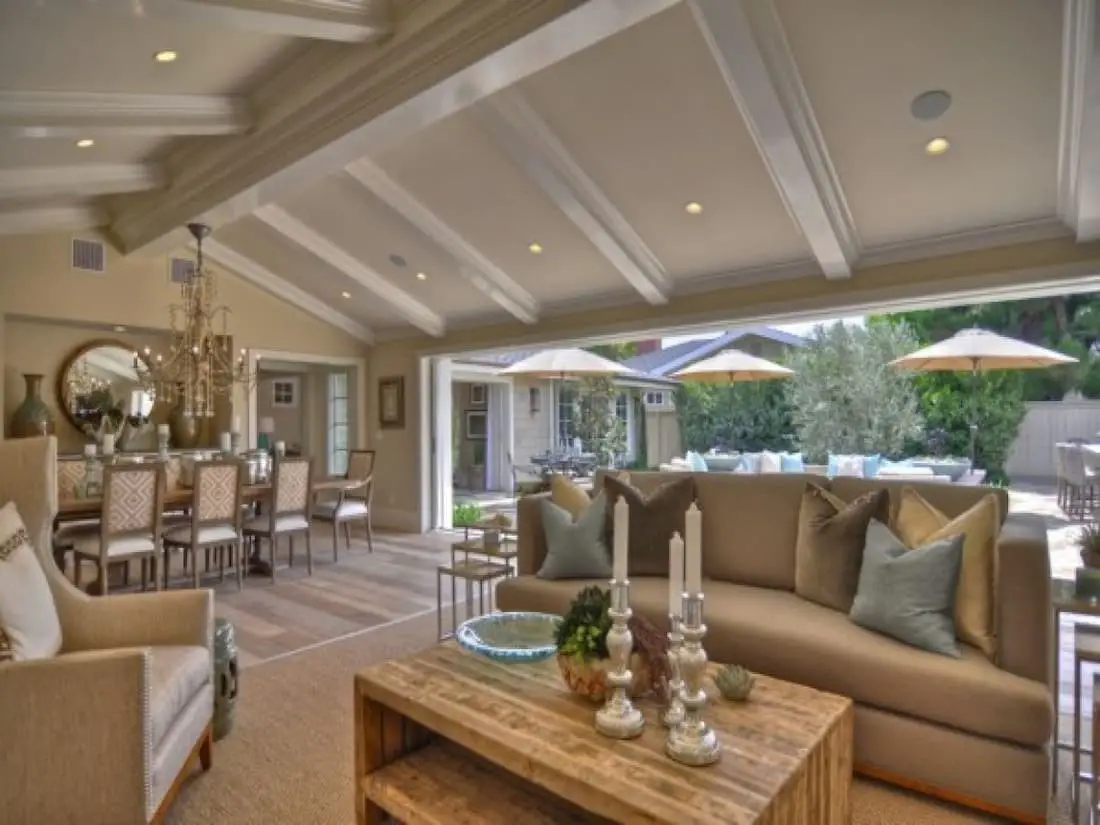
While a sloping ceiling might initially seem like a limitation, it can actually be leveraged to create a stunning space. The all-white, angled coffered ceiling in this room is a perfect example, providing a neutral modern aesthetic that effectively maximizes natural light with the help of grey walls and beige flooring. The strategic placement of canned lights and wall lights adds to the room’s overall brightness and ambiance.
In terms of creating an open, airy feel, vaulted coffered ceilings can be particularly effective when used on a sloped ceiling. A large, rectangular grid pattern applied throughout the space creates a seamless, spacious look that truly sets this transitional room apart.
FAQs
Are coffered ceilings outdated?
While tray ceilings have gained popularity for their practicality, the classic appeal of coffered ceilings remains unwavering. Interior designers and contractors concur that coffered ceilings are timeless and never truly go out of style. The result is a room transformed into a luxurious sanctuary that effortlessly exudes sophistication.
Can beadboard be used for coffered ceilings?
While often associated with rustic or vintage decor, beadboard’s versatility makes it a popular choice for coffered ceilings. Its lightweight and affordable nature means it can be easily used to level out an uneven ceiling by adding shims as needed. Additionally, the tongue and groove design of beadboard makes it particularly well-suited for creating a beachy or coastal-inspired atmosphere in coffered ceilings.
How much does it cost to do a coffered ceiling?
According to industry estimates, the average cost of a coffered ceiling can range from $25 per square foot, factoring in labor costs but excluding additional expenses for trim materials, finials, and paint. This figure translates to a minimum cost of approximately $2,500 for a low-end installation and an average cost of around $3,300.
Do coffered ceilings add value?
While there’s no definitive percentage attached to its impact on resale value, industry experts estimate that a well-executed coffered ceiling can increase a home’s worth by as much as 16-20%. This makes it a high-value addition to any home improvement strategy.
What is the difference between a coffered ceiling and waffle ceiling?
A waffle ceiling can be seen as a variation of the more general coffered ceiling concept. While they share similarities, the primary distinction lies in the arrangement of beams, which in a waffle ceiling intersect to form small square compartments. This unique design creates a visually striking resemblance to waffles contained within a larger framework.
Box beam vs coffered ceiling
When it comes to ceiling designs, another key concept to grasp is the relationship between box beams and coffered ceilings. In reality, a box beam is simply another name for a coffered ceiling, where hollow beams are used to create a box-like pattern. However, when you combine this design with tray ceilings, you get a more complex multiple-tray ceiling that’s often referred to as a ‘box beam’.
Interestingly, some designers use the term ‘Crawford ceiling’ to describe this modern take on coffered and box-beam designs, emphasizing its contemporary appeal.
How deep is a coffered ceiling?
While traditional coffered ceilings typically range from 1.75 to 3.5 inches in depth, this design element is highly adaptable to suit specific rooms and material choices. You can easily customize the depth and dimensions of your coffered ceiling to create a unique look that harmonizes with your interior space, regardless of its size or architectural style.
Coffered ceiling dimensions
As we’ve explored the fundamental principles of coffered ceilings, let’s shift our focus to the critical aspect of ceiling dimensions. The typical range for the length of a single panel is between 3 and 5 inches, while the width spans from approximately 4.5 to 8.5 inches. These measurements provide a foundation for creating visually appealing and structurally sound coffered ceilings that elevate any room’s ambiance.
What is a coffered ceiling made of?
In contrast to their historical counterparts, modern coffered ceilings have undergone a significant transformation. Gone are the days when they were constructed from heavy materials like stone or hardwood, designed to withstand the test of time. Today, they are crafted from more practical and versatile materials such as rigid PVC or ceiling tiles. These modern materials provide several benefits, including reduced weight, ease of installation, durability, and a relatively affordable price point.
Are coffered ceilings considered structural?
While coffered ceilings may add an air of elegance to a room, they do not bear structural load and are therefore considered decorative features only. This understanding is what drives the recommendation for using alternative materials such as beadboard, drywall, faux beams, and reclaimed wood in their construction. These choices prioritize both aesthetic appeal and functional simplicity.
Do coffered ceilings make the room smaller?
While coffered ceilings can be versatile in creating various atmospheres, their effectiveness depends on the height of the ceiling. In general, they work well when paired with ceilings that are 9 feet or taller, as this allows them to create a sense of elevation and visual expansion. Conversely, on shorter ceilings (below 9 ft), thick exposed beams can have an opposite effect, making the room feel more cramped.
This design element can thus be used to achieve either an intimate, cozy atmosphere or a grand, expansive one, depending on the desired aesthetic.
Conclusion
Beyond mere visual appeal, coffered ceilings offer a multitude of unparallelled advantages. One significant benefit is the perception of increased spaciousness, which can have a profound impact on the overall ambiance of a room. Additionally, these ceiling designs effectively conceal structural flaws and provide superior soundproofing and insulation capabilities. Furthermore, the installation of coffered ceilings can significantly boost a property’s resale value.
Considering these numerous benefits, it is clear that coffered ceilings are a worthwhile investment for any homeowner. To reap these rewards, one must simply select a design that harmoniously complements their home’s unique character.
Related Posts
While pellet stoves are often associated with heating smaller spaces, such as individual rooms or apartments, the question remains whether they can effectively heat an entire house. The answer lies in understanding how pellet stoves work and their limitations. Unlike traditional wood-burning fireplaces that rely on convection to distribute heat, pellet stoves use a combination of convection and radiation to warm the surrounding air.
This unique heating mechanism allows them to efficiently distribute heat throughout a larger space. However, it’s essential to consider factors such as the size of the stove, the insulation and construction of the house, and the desired temperature range when determining whether a pellet stove can adequately heat an entire home.

